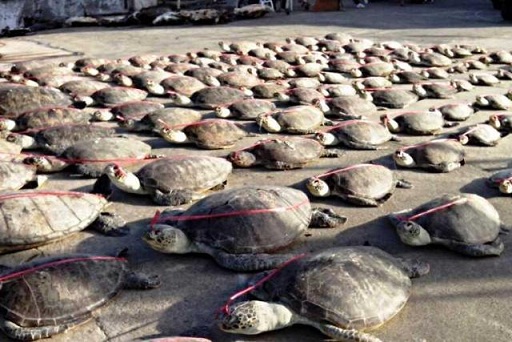The current tension in the South China Sea triggered by China’s territorial assertiveness underscores the military weakness of the Philippines and the lack of direction of its foreign policy as against Vietnam’s focused moves backed up by a credible defense capacity.
There are three incidents or conflicts going on in South China Sea that have raised the tension to worrisome levels.
One of the incidents involves Vietnam against China over the latter’s setting up of an oil rig in the disputed Paracel islands, 220 kilometers from Vietnam’s shores.
The two other incidents are between the Philippines and China. The first one was the arrest last May 6 by Philippine authorities of 11 Chinese fishermen off Half Moon Shoal (Philippine name:Hasa-Hasa shoal) in the disputed Spratlys area in the South China Sea. Seized with the fishermen were 500 turtles, some already dead. Many of the turtles belonged to endangered species.
Nine of the 11 fishermen have been charged in court for illegal entry and poaching of endangered species. They are currently under detention in Palawan. Two were found to be minors and have been allowed to return to China.The second issue is the construction by China of what Philippine authorities suspect is an airstrip in Johnson South (Philippine name: Mabini) Reef. In the case filed by the Philippines against China’s nine-dash line map before the United Nations Arbitral Tribunal, Johnson South Reef, 180 nautical miles from Palawan, was among the eight rocks cited as illegally occupied by China. It is also being claimed by Vietnam.
Aside from the Philippines, China,and Vietnam, Malaysia, Brunei and Taiwan also claim some of the islands in South China Sea.
The Department of Foreign Affairs released photos of Chinese installations in Johnson South Reef, which it says, is a violation of the 2002 Declaration on the Conduct of Parties in the South China Sea (DOC) signed by Asean members and China where they agreed to maintain the status quo and not to build new structures in the disputed areas.
The Philippines said the reclamation done by China in Johnson South Reef turned the bean-shaped rock into a 30-hectare (74-acre) land mass.
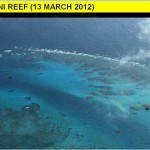
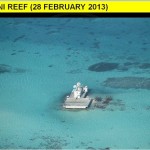
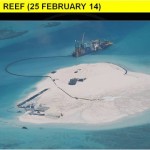
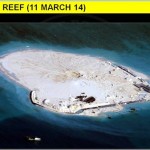
China dismissed the Philippine protest over their Johnson South construction insisting their right to do anything in their own territory. “I wonder what special motives there are behind such concerns by the Philippines,” China Foreign Ministry spokeswoman Hua Chunying said at a news conference in Beijing.
At Halfmoon Shoal, near Ayungin Shoal where BRP Sierra Madre was purposely grounded in 1999 and served as Philippine Marines detachment, China sent two surveillance ships after the arrest of the 11 fishermen. They have not left the area since and are now in control of shoal. Looks like another Scarborough Shoal.
Philippine authorities have advised Filipino fishermen not to venture into the area near Halfmoon Shoal as Chinese authorities might retaliate by arresting them.
Philippine reaction to China’s aggression has been limited to filing diplomatic protests and issuing statements to elicit sympathy from the international community.
Vietnam, meanwhile, took China head on.
China admitted that they were shocked when Vietnam sent their own flotilla of ships and engaged them in a water cannon battle in the high seas.
Vietnam said some 86 Chinese ships plus war planes are guarding the oil rig installations. On their part, Nguyen Ngoc Oai, head of the Fisheries Control Department , said 30 vessels of the fishery control and marine police forces of Vietnam are operating in the area. About 20 Vietnamese fishing vessels are about 20 kilometers from the rig.
Vietnam is demanding that China remove the oil rig from Paracels, site of a violent clash between China and South Vietnam (before the 1975 reunification of North and South Vietnam) 40 years ago which resulted in the sinking of a South Vietnamese warship and death of more than 50 soldiers.
Yi Xianliang, deputy director general of China’s Ministry of Foreign Affairs, admitted to media in Beijing that authorities were “shocked” by the Vietnamese behavior and Chinese vessels are taking measures to protect themselves.
They are now asking Vietnam to stop harassing Chinese personnel in the oil rig to which Vietnam said he “Vietnamese fisheries surveillance force and Coast Guard will make no concession to the Chinese and they will appropriately respond to any violations of Vietnam’s sovereignty.”
Meanwhile, anti-China protests have intensified in Vietnam escalating into riots. Two have been reported killed and 90 injured. The commerce ministers of both countries were reported to have met Friday in Qingdao, China to discuss the hostilities that are affecting Chinese investments in Vietnam.
Despite conflicting claims in the South China Sea, Vietnam and China enjoy dynamic relations.
Last year during Vietnamese President Truong Tan Sang’s visit to Beijing, he and Chinese President Xi Jinping agreed to establish a hotline to prevent maritime disputes from straining diplomatic relations.
Vietnam did not accede to a Philippine request to join in the suit against China before the U.N. Arbitral Tribunal anticipating that if they did so China would immediately move into their land border or occupy rocks or reefs in the Spratlys.
Vietnam’s nationalistic and well-calculated moves have been formed from its painful history with colonial powers.An article by Ngo Minh Tri and Koh Swee Lean Collin, “Lessons from the Battle of the Paracel Islands” in the online publication, The Diplomat, enumerated the valuable lessons they learned from the 1974 Paracels debacle:
One, diplomacy is the first recourse… but not the sole recourse.
Two,extra-regional powers neither always stay… or always ‘Help.’
The authors noted that none of the extra-regional powers has taken any side on the South China Sea disputes, preferring to focus only on freedom of navigation.
They disclosed that in the 1974 clash at Paracels, Saigon sought assistance from the U.S. Seventh Fleet, but it was under orders not to intervene in the disputes and no help arrived.
Three, the need for at least limited sea control capabilities.
The authors said “While diplomacy is the preferred recourse and extra-regional powers have become more heavily involved in the region, adequate military power in the form of defense self-help remains necessary, especially when the area continues to be fraught with uncertainty.”
The Philippines, on the other hand, has not modernized its military, the only coastal state in Southeast Asia without a submarine. Its Air Force is a butt of joke: All air, no force.
Philippine officials also continue to delude themselves and the people that the United States will send their troops in case of an armed conflict with the Chinese in the Spratlys.
Retired Commodore Rex Robles said, “We are paying for years of neglect.”
President Aquino said he will stick to “diplomacy” to solve the current crisis triggered China’s new construction of facilities in the disputed areas in the South China Sea.
It is doubtful if he understands clearly the intricacies of the “diplomacy” he is talking about. He is putting so much hope on the ASEAN Code of Conduct in the South China Sea, which would need China’s concurrence. Diplomatic experts do not see an Asean Code of Conduct in the South China Sea signed in two years time.
Aquino also cited the case filed by the Philippines with the U.N. Arbitral Court to declare as illegal China’s nine-dash line map. But former Ambassador to the United Nations Lauro Baja,Jr, is of the opinion that when the Philippines sued China before a U.N. court,”That was the end of diplomacy.”
Also, the decision on the U.N.case is expected in two to three years. Even if the decision would be in favor of the Philippines, since China refused to participate in the U.N. arbitration, it is not compelled to abide by the decision.
The Philippines and China are also at odds on the form of talks with the latter preferring bilateral talks and the former insisting on a multi-lateral forum involving other Asean members.
Baja said the Philippines’ refusal to talk one-on-one with China is a mistake because there are issues, like Scarborough Shoal, that are bilateral in nature.
“The negotiating table is the greatest equalizer in international relations,“he said, adding that Philippine officials should “Be not afraid.”
“Provided the Philippine Team is fully prepared before they negotiate there is nothing to fear that the other side can take advantage of us. It’s a mental baggage which should be excised now before we are totally paralyzed,” Baja said.
The current crisis in the South China Sea should make Philippine officials see the need for a major overhaul in dealing with the South China Sea problem and attitude towards China. They can take lessons from Vietnam.

